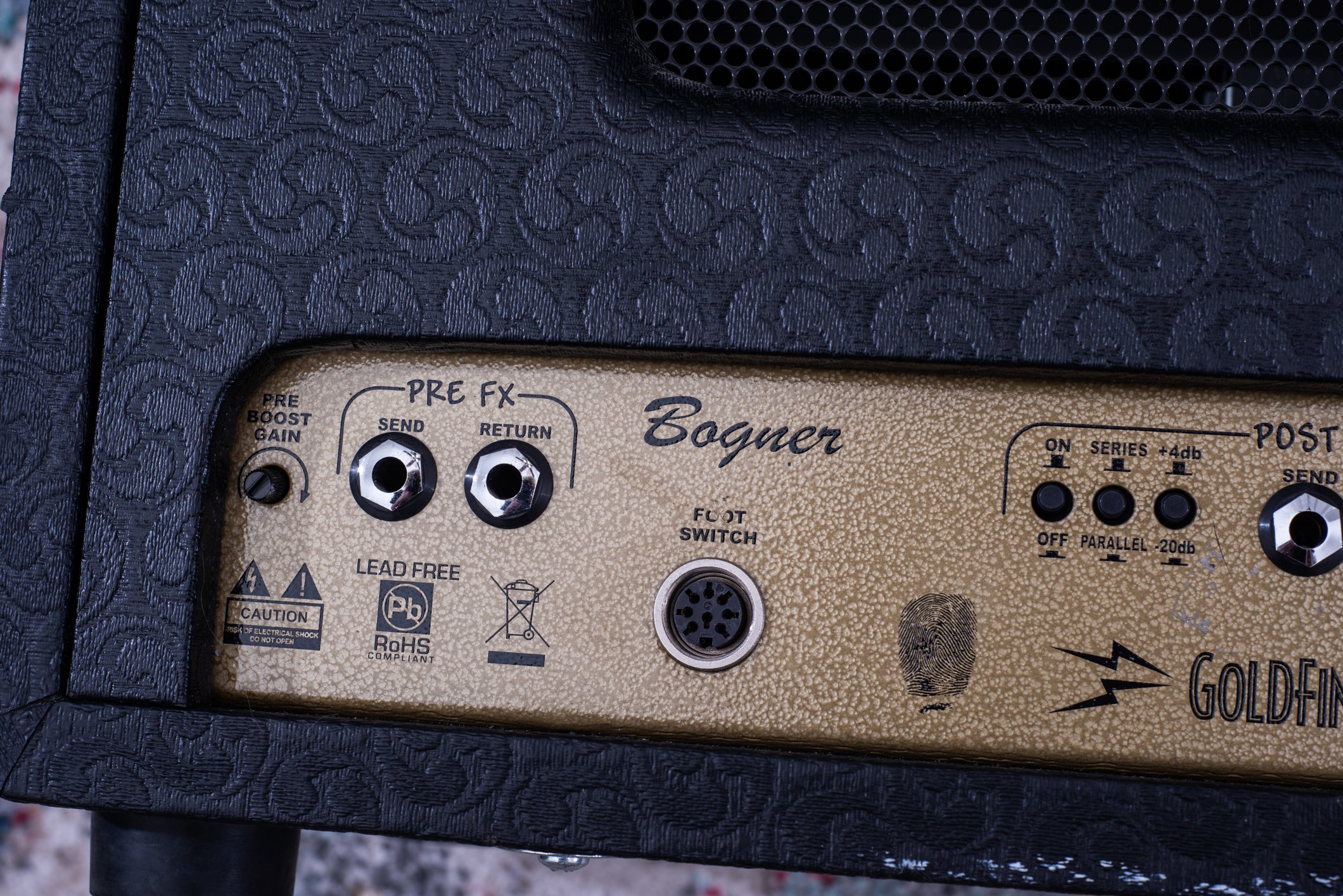2011 Bogner Goldfinger GF45
Specs
2 Channels
45w Output
4x 6V6 Power Tubes
4x 12AX7 Preamp tubes
Adjustable, Footswitchable boost function
Spring reverb
$2429 in 2012
Overview
This was the first Bogner amp I purchased, used and pretty worn aesthetically but functionally perfect. It has a kind of strange look, in almost a plexi-style headshell but with a double-height gold front panel and an odd assortment of larger and smaller knobs.
There are two channels, called “Alpha” and “Omega.” The Alpha channel is a clean channel with what feels like a Fender-style circuit, but with a gain and mids eq control. The most drastic effect on this channel’s tone are the two bright switches, which are located at different spots in the circuit. The “pre bright” is tied to the gain control, so higher gain settings lessen the effect of this - similar to the bright cap across the volume on a plexi’s high treble channel. When the gain control is maxed, it’s effectively the same as if the bright cap is engaged fully anyway, but when the gain is rolled off, it can be used to allow more high frequencies through. The second bright control appears to be in a later stage, and has a post-EQ kind of feel. It’s much more subtle, bringing it a little high mid punch when you need more cut without being too aggressive. It’s also worth mentioning that even with high powered humbuckers, the gain control really does not let this channel get dirty - it’s extremely clean even with the gain maxed out. It does add more compression and changes the feel when playing the amp, and it also changes the amount of hair you get when the boost is engaged - more on that in a moment.
The Omega channel is clearly a Marshall plexi inspired tone, and it’s actually so convincing that playing this amp side by side with my 1987X it is hard to tell them apart. All of the pleasant sounds of a true plexi are there - and also all of its shortcomings, especially in the looseness of muted low strings. Some might describe this as a “round” low end sound. This channel has the same 3-band EQ, gain, and loudness (volume) controls as the other channel, but the middle large knob is titled ‘Gain EQ,” and that’s the real draw of this channel. This can be turned anywhere from minimum to full without losing the signal, and it basically dictates how bright (to the left) or bassy (to the right) this channel sounds. It’s not a massive range, but it feels very similar to adjusting the blend between the Normal and High Treble channels on a jumpered plexi. In fact, if you told me that this amp had two parallel signal paths in the gain stages, the same way a plexi works, I would believe you! This channel also has two modes - a “69” mode (did you know this amp was based on a plexi?!) and an “80” mode. I far prefer 69 mode, which is just a solid raw, mid-gain rock tone. The “80” mode introduces diode clipping across the volume, “Jose” style, which drops the signal volume substantially and it just doesn’t jump out at me as the strong suite of this amp, even though it sounds very good generally speaking.
Next I want to talk about the boost, which is footswitchable. This clean boost can be adjusted in amount from a tiny knurled knob on the rear panel, and engaged on either channel. On the Alpha channel, it can effectively be nothing but a clean volume boost (gain lower) or can be used to introduce some dirt as well as volume (gain maxed). On Omega, it can be used to push the amp into a pseudo-high gain territory, adding punch and saturation to leads and even cleaning up those round palm mutes I mentioned earlier, especially in the “80” mode. The amp would still need an external boost of some kind to do very heavy music styles, but this boost is very effective at expanding the range and versatility of this amp.
This amp also houses a full size, long spring reverb, usable on both channels, but sharing a single mix control. This is a really great sounding reverb and adds a lot to the clean tones of the amp and I find it still useful on most of the mid-gain tones as well without having to adjust the mix, but it can also be controlled from the footswitch in a live situation.
Recently, a new model of this amp has been released called the Goldfinger SL+. That amp has an additional mode on the Omega channel called “77” which has absolutely glowing reviews across the web - if I had to guess, it’s a take on a metalface era Marshall JMP, which would give that amp a very nice middle ground between the ‘69 and ‘80 modes, with a bit more gain and punch (and likely a tightened up low end).


















